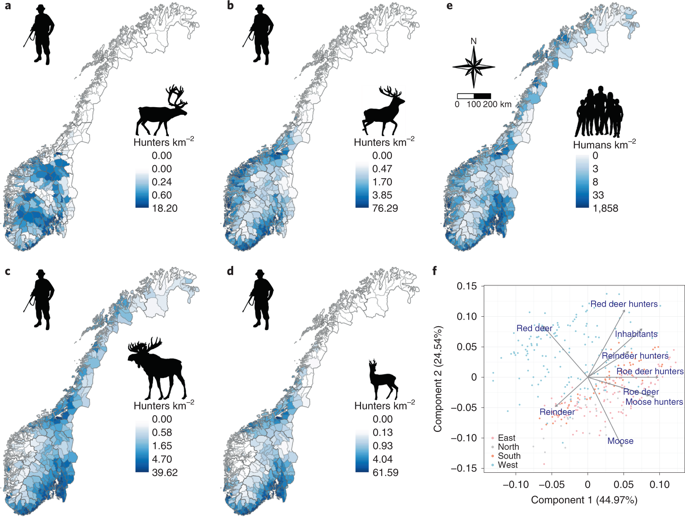Nature Human Behaviour ( IF 21.4 ) Pub Date : 2020-03-16 , DOI: 10.1038/s41562-020-0836-7 Atle Mysterud 1 , Inger M Rivrud 2 , Vegard Gundersen 3 , Christer M Rolandsen 4 , Hildegunn Viljugrein 5

|
Human hunters are described as ‘superpredators’ with a unique ecology. Chronic wasting disease among cervids and African swine fever among wild boar are emerging wildlife diseases in Europe, with huge economic and cultural repercussions. Understanding hunter movements at broad scales has implications for how to control the spread of these diseases. Here we show, based on analysis of the settlement patterns and movements of hunters of reindeer (n = 9,685), red deer (n = 47,845), moose (n = 60,365) and roe deer (n = 42,530) from across Norway (2001–2017), that hunter density was more closely linked to human density than prey density and that hunters were largely migratory, aggregated with increasing regional prey densities and often used dogs. Hunter movements extended across Europe and to other continents. Our results provide extensive evidence that the broad-scale movements and residency patterns of postindustrial hunters relative to their prey differ from those of large carnivores.
中文翻译:

人类猎人独特的空间生态。
猎人被描述为具有独特生态的“超级掠食者”。鹿的慢性浪费性疾病和野猪的非洲猪瘟是欧洲新兴的野生动植物疾病,在经济和文化方面产生了巨大影响。广泛了解猎人的活动对如何控制这些疾病的传播具有影响。在此我们根据对驯鹿(n = 9,685),马鹿(n = 47,845),驼鹿(n = 60,365)和ro(n = 42,530)来自挪威各地(2001-2017年),猎人的密度与人类的密度比猎物的密度更紧密相关,并且猎人主要是迁徙,聚集了越来越多的地区猎物密度并且经常使用狗。猎人运动扩展到整个欧洲和其他大陆。我们的结果提供了广泛的证据,表明工业后猎人相对于猎物的大规模运动和居住模式与大型食肉动物不同。











































 京公网安备 11010802027423号
京公网安备 11010802027423号